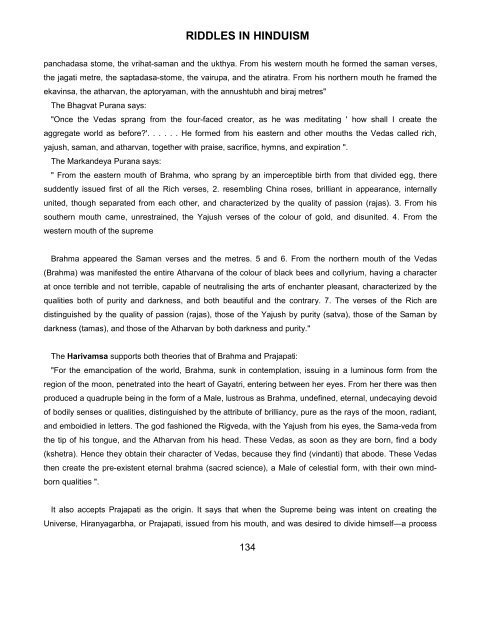Create successful ePaper yourself
Turn your PDF publications into a flip-book with our unique Google optimized e-Paper software.
RIDDLES IN HINDUISM<br />
panchadasa stome, the vrihat-saman and the ukthya. From his western mouth he formed the saman verses,<br />
the jagati metre, the saptadasa-stome, the vairupa, and the atiratra. From his northern mouth he framed the<br />
ekav<strong>in</strong>sa, the atharvan, the aptoryaman, with the annushtubh and biraj metres"<br />
The Bhagvat Purana says:<br />
"Once the Vedas sprang from the four-faced creator, as he was meditat<strong>in</strong>g ' how shall I create the<br />
aggregate world as before?'. . . . . . He formed from his eastern and other mouths the Vedas called rich,<br />
yajush, saman, and atharvan, together with praise, sacrifice, hymns, and expiration ".<br />
The Markandeya Purana says:<br />
" From the eastern mouth of Brahma, who sprang by an imperceptible birth from that divided egg, there<br />
suddently issued first of all the Rich verses, 2. resembl<strong>in</strong>g Ch<strong>in</strong>a roses, brilliant <strong>in</strong> appearance, <strong>in</strong>ternally<br />
united, though separated from each other, and characterized by the quality of passion (rajas). 3. From his<br />
southern mouth came, unrestra<strong>in</strong>ed, the Yajush verses of the colour of gold, and disunited. 4. From the<br />
western mouth of the supreme<br />
Brahma appeared the Saman verses and the metres. 5 and 6. From the northern mouth of the Vedas<br />
(Brahma) was manifested the entire Atharvana of the colour of black bees and collyrium, hav<strong>in</strong>g a character<br />
at once terrible and not terrible, capable of neutralis<strong>in</strong>g the arts of enchanter pleasant, characterized by the<br />
qualities both of purity and darkness, and both beautiful and the contrary. 7. The verses of the Rich are<br />
dist<strong>in</strong>guished by the quality of passion (rajas), those of the Yajush by purity (satva), those of the Saman by<br />
darkness (tamas), and those of the Atharvan by both darkness and purity."<br />
The Harivamsa supports both theories that of Brahma and Prajapati:<br />
"For the emancipation of the world, Brahma, sunk <strong>in</strong> contemplation, issu<strong>in</strong>g <strong>in</strong> a lum<strong>in</strong>ous form from the<br />
region of the moon, penetrated <strong>in</strong>to the heart of Gayatri, enter<strong>in</strong>g between her eyes. From her there was then<br />
produced a quadruple be<strong>in</strong>g <strong>in</strong> the form of a Male, lustrous as Brahma, undef<strong>in</strong>ed, eternal, undecay<strong>in</strong>g devoid<br />
of bodily senses or qualities, dist<strong>in</strong>guished by the attribute of brilliancy, pure as the rays of the moon, radiant,<br />
and emboidied <strong>in</strong> letters. The god fashioned the Rigveda, with the Yajush from his eyes, the Sama-veda from<br />
the tip of his tongue, and the Atharvan from his head. These Vedas, as soon as they are born, f<strong>in</strong>d a body<br />
(kshetra). Hence they obta<strong>in</strong> their character of Vedas, because they f<strong>in</strong>d (v<strong>in</strong>danti) that abode. These Vedas<br />
then create the pre-existent eternal brahma (sacred science), a Male of celestial form, with their own m<strong>in</strong>dborn<br />
qualities ".<br />
It also accepts Prajapati as the orig<strong>in</strong>. It says that when the Supreme be<strong>in</strong>g was <strong>in</strong>tent on creat<strong>in</strong>g the<br />
Universe, Hiranyagarbha, or Prajapati, issued from his mouth, and was desired to divide himself—a process<br />
134


















